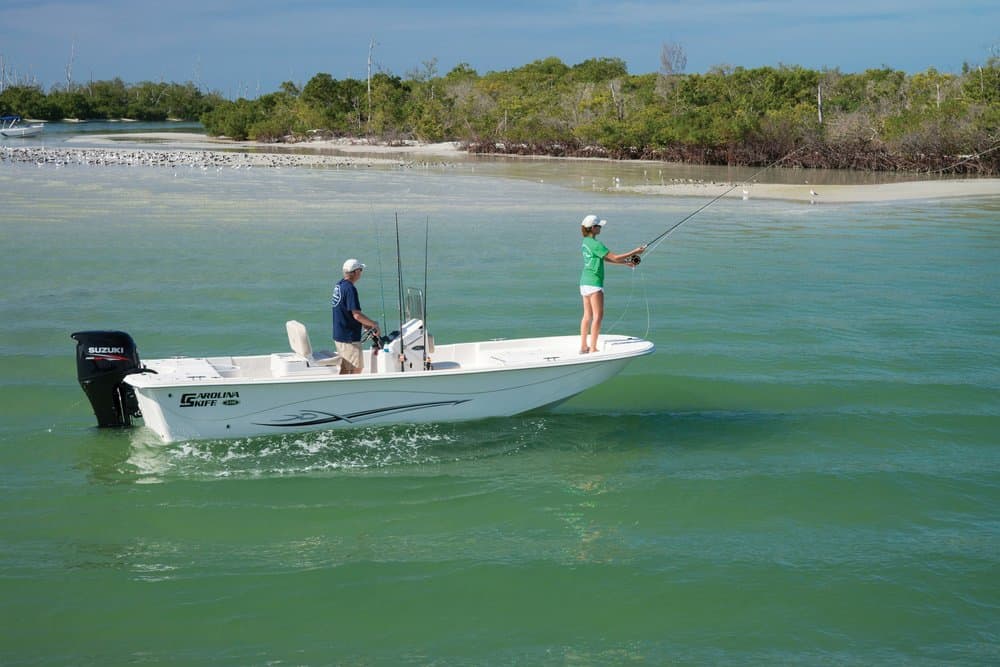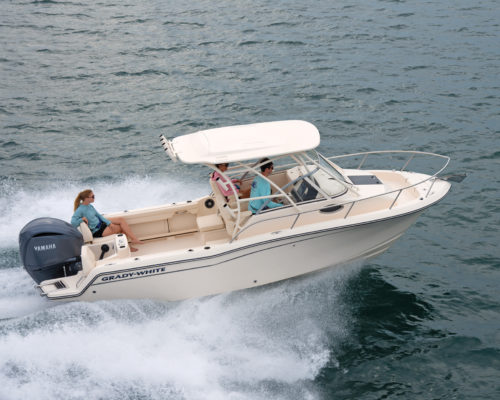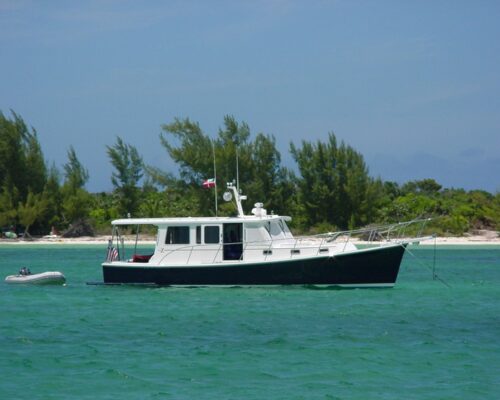“Volume, affordability, and durability. Two kids, a wife, a dog, a bunch of toys (tow tubes at the moment, fishing gear at other times), a thirst for faraway as well as close-to-home waters, plus friends who aren’t easy on gear.” According to owner and Chesapeake Bay Foundation’s Maryland director of major giving John “Rody” Rodenhausen, “This is the boat we needed for all-purpose fun and a bit of social work.”
Loon Call is a busy family boat that has supported some serious adventures in her first three years. “I did my homework at boat shows with a tape measure, to make sure I was getting a boat that can hold a pair of tent cots for sleeping aboard,” he says.
This Carolina Skiff 218 DLV is able, durable, fast but efficient with her 115-hp Suzuki outboard, light enough to tow behind a compact crew-cab pickup truck, and roomy enough for all of Rody’s needs, including occasional jobs for CBF. She already knows Chesapeake waters from Annapolis to lower Tangier Sound, as well as the seaside of Virginia’s Eastern Shore around Oyster and Virginia Beach’s Lynnhaven River. She has even hosted an expedition through the Florida Keys. There aren’t many boats that can offer such versatility, especially at this price.
Carolina Skiff 218 DLV
- LOA: 20’10”
- Beam: 96″
- Draft: 6″
- Weight:1,773 Lbs
- Transom Height: 25″ Max
- HP: 150
- Carolinaskiff.com
If it sounds as if Rody opted for a waterborne pickup truck, you’re not far off. In fact, Carolina Skiff used to advertise a photo of its 2790 DLX-EW flat-bottom model carrying a Ford F-150 truck. Loon Call, though, has the modified tri-V hull, not unlike the underside of my 17-foot Boston Whaler Montauk, with a shallow-V shape in the center, a pair of lifting strakes, broad chines, and an “eyebrow” around the bow to knock down spray from the front of the hull. One small but important design detail is a slight downward hook at the aft end of each chine, which acts like a trim tab to help lift the hull onto plane. Her eight-foot beam offers solid stability at rest and underway and prodigious carrying capacity complemented by the civilized but robust Suzuki 115, which has a reputation for power.
Just like those of us who run old Montauks in open water, Rody has had to learn to make Loon Call comfortable for his crew. In calm water with a light load, she’ll top 35 knots, and she cruises easily in the mid-20s with the whole family, dog, gear, toys, food, and refreshments aboard. When things get choppy, though, her great benefit is being able to stay on plane at speeds as low as 10 knots, riding over the waves like a cork. She comes up on top like a big roller skate. This capability gives Loon Call a wide range of usable speeds to fit conditions on any given day. “When it gets rough,” says her skipper, “I pick my company, slow down, and don oilskins. She holds her own, but there are limits.”
Carolina Skiffs are rigged simply. The 218 DLV is a rolled-edge hull with gunwales that come out of the mold curving outward so the undersides are accessible, unlike the usual shoe-box construction of two-part boats with a separate deck part. Therein also lies some of the cost savings. Attaching deck modules fore and aft means bedding them down on the gunwales, bolting them on with washers and locknuts, and sealing the interior edges. The system allows multiple options. Loon Call’s afterdeck includes fold-down jump seats port and starboard,
with storage underneath and a livewell in the center just forward of a 30-gallon fuel tank. The bow deck also offers two storage compartments.
All that storage allows for family trip needs and for the longer overnight or consecutive night expeditions that Rody calls on Loon Call to host. Her simple layout gives him ready access for aftermarket rigging. To date, that has included a second battery for backup and house needs, a bimini top (easy to install on the rolled-edge gunwales), and a system for cooking and sleeping in any reasonable weather. On the Keys fishing trip, he and a colleague lived on the boat for a week without ever going ashore.
The Rodenhausens are experienced campers, so the tripto Oyster and Lynnhaven involved campgrounds and launch ramps. The well-loved Toyota Tacoma crew-cab pickup is an integral part of the system. What does a typical weekend around Annapolis look like for Loon Call? Local day trips, tubing, and especially ice cream runs downtown. “She’s a near-town runabout that’s safe in the open Bay,” Rody says with a smile.
Fishing? He reports that, “Casting from her bow deck is like fishing from an aircraft carrier…her shallow draft is great for flats like the ones in Tangier Sound.”
In a world of outboard boats that cost more than houses used to, it’s important that prospective buyers think through their needs realistically and do their homework. Not too much, and not too little. That’s the process that leads to a sweet spot in boat ownership. Loon Call is a great example. She is very wise in her choice of owners.
Base price for a Carolina Skiff 218 DLV with a 115-hp Suzuki and trailer is $25,500.




